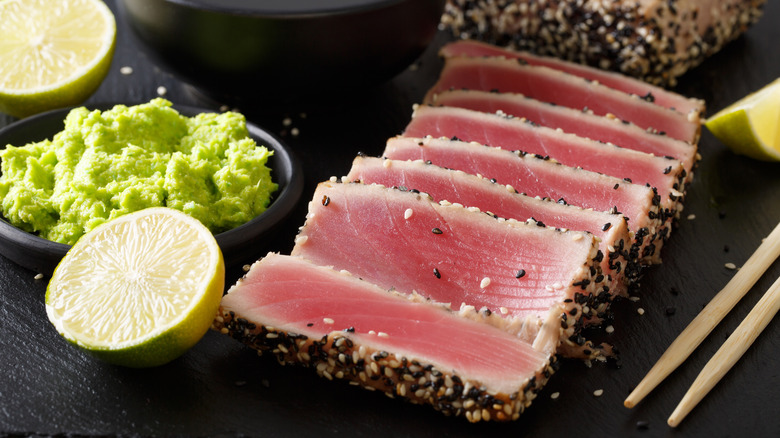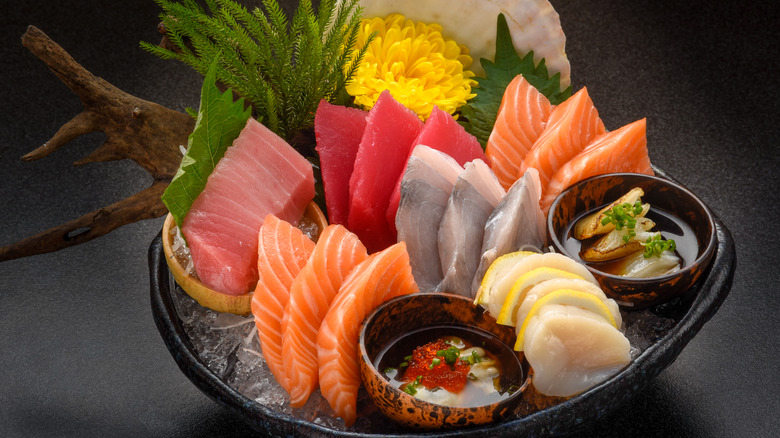The Difference Between Tataki And Sashimi
For those new to eating sushi and other kinds of Japanese food, the cuisine might be surprising at first. It's a balancing act of flavors that are paradoxically delicate and bold, with textures both sturdy and soft and with a vocabulary all its own. Though raw fish is unfamiliar to some American palates, servers in most sushi restaurants are accustomed to answering questions like "What is hamachi?" and "What's in a Philadelphia roll?" Hamachi, by the way, is a fish that's also called yellowtail or Japanese amberjack. And a California roll contains rice, imitation crab sticks, cucumber, avocado, and sesame seeds, in a nori (dried seaweed) wrapper.
Many sushi novices start out with the least intimidating rolls like a California roll or a shrimp tempura roll, both of which contain cooked seafood, along with fresh veggies. As sushi eaters become more knowledgeable, they typically explore more of the menu, learning new cooking methods, new terminology, and new ingredients. Understanding categories of sushi and Japanese cuisine is useful as you broaden your palate and savor new flavors and textures.
What is tataki?
You might have come across "tataki" on a menu and been unfamiliar with the term. According to Fine Dining Lovers, Tataki is a cooking method that is typically used for fish, often tuna, but can also be used for other protein sources like beef. Per the website, tuna tataki is first marinated in a combination of ingredients that bring in salty, sweet, and acidic notes that complement the flavors of tuna. Soy sauce usually contributes saltiness, and the acid can come from vinegar or citrus juice, commonly lime juice or yuzu juice.
Taste Atlas explains that after briefly marinating, the tuna is quickly seared in a very hot pan or grill, turned to ensure each side gets the perfect sear. After cooking, the tuna is quickly chilled to stop the fish from continuing to cook. When it's properly chilled, the meat is sliced and served with ponzu sauce or soy sauce, often accompanied by daikon and pickled ginger. Though tataki is quickly seared, the center of the tuna remains raw, so the dish presents two different textures and experiences of excellent tuna, brightened and enhanced by acidity, sweetness, and savory sauces.
What is sashimi?
Sashimi, like tataki, is thinly sliced meat, usually fish, but it's served in its purest form (via Japan Guide). Sashimi is served raw and unadorned. Commonly confused with nigiri, which is raw fish served over a ball of seasoned rice (per Kobe Teppanyaki), sashimi allows the flavors of each kind of fish to shine on its own. Sashimi is frequently eaten with a tiny bit of wasabi and is dipped in a little soy sauce.
Because sashimi is neither marinated nor cooked, it's possible to savor the unique flavors of each kind of fish. According to Question Japan, common kinds of fish served up as sashimi include hamachi, sake (salmon), hotate (scallop), tai (red snapper), ika (squid), ahi (yellowfin and bigeye tuna), and hokkigai (clam).
Thankfully you don't have to make a choice between tataki or sashimi; the perfect meal can contain more than one component. Instead, the next time you're at a Japanese restaurant build yourself a multicourse meal. Start with fresh, delicate sashimi, move on to a flavorful, light tataki, and finish with a heartier sushi roll. It would be a journey for the palate and pair nicely with a dry Riesling.


